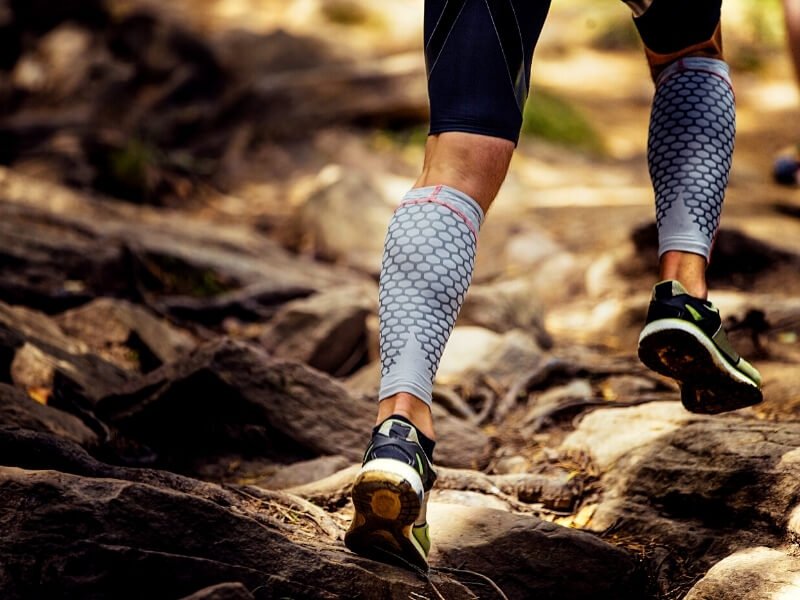Last Updated on July 5, 2021 by Dr Sharon Baisil MD
Diabetic neuropathy is one such physical sign of distress in the body caused as a result of diabetes. Among some common ways to treat this condition is the use of Compression socks.
Compression socks are good for individuals with diabetes, as they can help to combat nerve damage due to diabetic neuropathy. Let us look into greater detail of this issue and how the use of compression socks proves to be beneficial.
How do Compression socks help diabetics with neuropathy?
Anyone diagnosed with the typical blood sugar level ailment of diabetes is prone to risks such as – venous insufficiency, DVT – Deep Vein Thrombosis, Blood circulation issues, Peripheral edema, foot ulcers, etc.
Thus, proper care for the foot to prevent such injuries and symptoms is essential for maintenance and healthy life. Socks with compression therapy abilities prove to be great as treatments for foot conditions in diabetics.
Well, compression socks are varieties of tightly-fitted socks that help in balancing the pressure in your legs. The compression power of these socks helps in applying a gradient pressure onto your legs. As a result, there is an improvement in the blood circulation in your legs.
These snugly fitting stockings are very different from regular socks. They are made from stretchy and comfortable material specially designed and tailored to apply a certain pressure to the ligaments in the legs and feet.
Instead of the blood resting at the bottom of your legs in your feet, which gives rise to a numb or painful situation, the tight compression socks prevent this collection of blood in the feet and help it rise back up through the veins and continue the circulation efficiently.
These socks are meant to provide comparatively greater pressure on the foot area, instead of the calves. This feature is termed as the ‘graduated compression.’ The subtle heightened pressure on the ligaments of the ankles and bottom of the foot is useful in directing good blood flow.
__________________________________
⭐ Check out this Flipbook with 30-Day Diabetic Meal Plan based on Foods from Each Indian State ⭐
(click on the ▶ arrow below to scroll the pages and 🔍 button to enlarge)
_____________________________
The compression socks get less tight as the garment moves upward on the legs. As a result, circulation is better maintained, and the risk of blood collection at the bottom of your leg is prevented.
Well, how do compression socks help in improving circulation in diabetes?
The built and design of the compression socks are made to encourage the oxygen-rich blood flow from the arteries to the muscles, creating relaxation.
This relaxation leads to a simultaneous pressure on the veins to push more blood towards the heart for continuous circulation of blood.
The mechanism behind compression sock therapy encourages blood circulation to parts of the body that have neurological symptoms caused due to diabetes.
8 Features of good quality Compression socks for Diabetes
Such compression sock treatments help avoid swellings, wounds, and sensitivity disorders forming in the feet.
Another benefit of wearing compression socks is that it keeps the feet safe. It prevents the risks of foot ulcers, injuries, cuts, sores, etc. that go unnoticed, yet prove harmful for diabetic neuropathy. They can take a long time to heal completely and can turn into more significant injuries.
A proper-fitting compression sock, according to your feet, creates protection over your feet and fragile toes. Problems caused due to improperly fitted socks or shoes, rubbing of socks leading to skin breakouts, other reactions due to improper circulation, etc. are corrected by the wearing of compression socks.
These socks provide you with tightly fitted, yet comfortable coverage. There are extra padded areas with a flat seam. These features help reduce wrinkling and decrease friction in the feet to prevent the occurrences of blisters and foot sores.
- A Snug fit – The fabric used in the making of socks is chosen from firm materials to avoid loosening and ensure a tight hold of the leg in a good position from the feet, ankle, and upwards. The tight fit helps to provide the necessary pressure on the feet. It is also beneficial to have a tightly fitted sock as the loose fabric from regular socks can often rub against your skin and give rise to injuries, calluses, blisters, and other infections.
- Provided Padding in the socks – Padded socks is useful in keeping the leg safe and cushioned. In the case of compression socks, this quality also makes it efficient to apply the correct pressure.
- Seamless – All regular socks come with seams. The presence of seams in a sock can make it risky for a diabetic individual’s feet because the seam rubbing against the skin can give rise to blisters, cuts, and ulcers. A diabetic person suffering from foot neuropathy can miss out on the sensation of pain in the feet. If these wounds go unnoticed, they can take time to heal, and this can result in more significant matters that are harmful.
- Breathable quality fabric – Compression socks are made out of sturdy and breathable materials. This helps a proper circulation of air between the feet and the socks, which helps keep the feet dry.
- Moisture-wicking – The quality of the fabric used is not just breathable, but also absorbs moisture. This feature prevents any moisture build-up that can lead to microbial infections. Keeping the feet aired and dried inside the socks is important.
- Warm – The socks worn for diabetic neuropathy can help to keep the feet warm as well. The warmth in the feet is necessary to supplement good blood circulation and keep the movement active. The pain also reduces due to a constant warm pressure on it that provides a feeling of comfort and ease.
- Square-toe boxed shape – The compression socks are usually made in a square shape till the toes, whereas regular socks seem to narrow down at the toe portions. A square shape encourages comfort and spacing between the toes, and it also ensures to prevent any factor that can cause moisture building up in the feet.
- Comfort – The socks are designed to provide enough comfort and support to one’s feet. It is not prone to cause itchiness and discomfort. A lot of varieties also offer an open-toe compression sock. You can choose one that suits your preferences.
As you choose a compression sock pair that will help your diabetic neuropathy, make sure to check your symptoms and opt for a fit and design based on that.
Do not forget to consider comfortable shoes that do not hamper your compression socks, and are safe with reduced risks of injuries.
It is also recommended to ask your doctor to suggest a suitable compression sock type that can prove beneficial for your feet condition and diabetes.
References
- https://www.sciencedirect.com/science/article/abs/pii/S0168822716302017
- https://journals.sagepub.com/doi/abs/10.1177/193229681200600319
- https://drc.bmj.com/content/8/1/e001316.abstract
- https://link.springer.com/article/10.1007/s00421-018-3929-5
- https://diabeticsockclub.com/blogs/news/how-do-diabetic-foot-ulcers-start
- https://pubmed.ncbi.nlm.nih.gov/28942323/
- https://www.mayoclinic.org/diseases-conditions/diabetic-neuropathy/symptoms-causes/syc-20371580
- https://www.healthline.com/health/find-right-diabetic-socks#precautions







